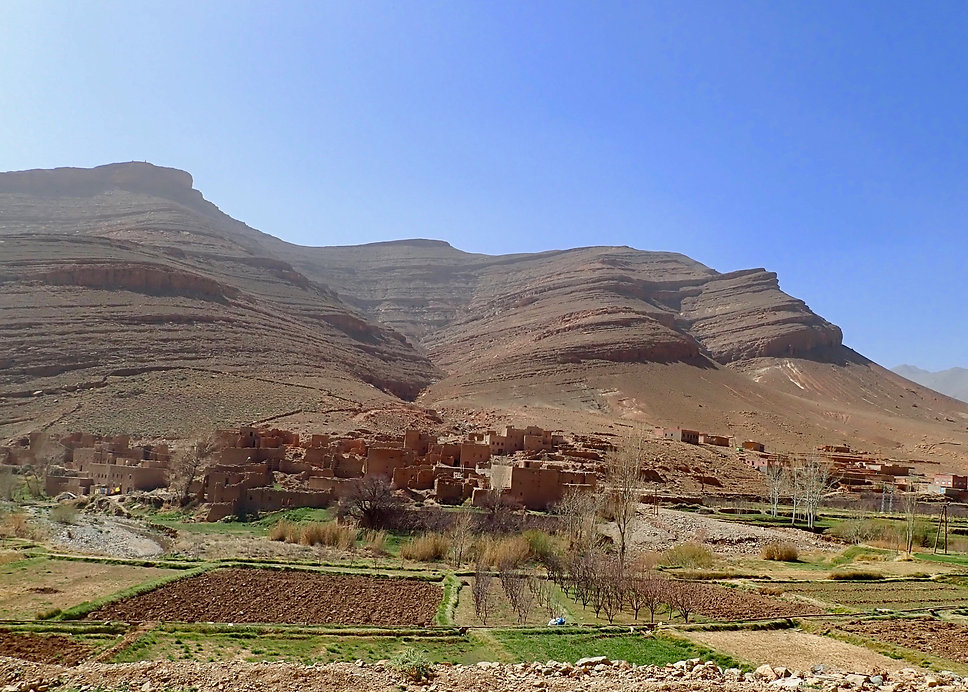The Supremacy of the Desert
Nownomadic2.com, 2/22/19 http://www.nownomadic2.com
Archive
October 2019
August 2019
February 2019
April 2018
December 2017
November 2017
Tags
Africa
Gorges
Morocco
Nomads
Oasis
Salt Mine
Tinghir
Travel
getaway
The Supremacy of the Desert
February 22, 2019
|
Brian Wilcox

We sit here in Tingher, Morocco just above a beautiful green oasis. The oasis surrounds a river that issues from a few different sources but comes mainly from the Todgha Gorge a few miles upstream. It does not fit my rather media born image of an oasis. The Hollywood kind seems always to be among the dunes, is a small round pond with one or two palm trees and attracts camel riding nomads and French Foreign Legionnaires.

This one is different. There is no pond, but a steady inpouring of fresh, cool mountain water from the High Atlas Mountains. Tingher is a town and a district. The people around here use this oasis to their full advantage. The water is managed, diverted, stored and used to bring a fecund harvest of things used every day by the Berber people here. In the midst of this long and green oasis there are olive trees, almond trees, pomegranate trees, date palms, peaches, apples, alfalfa, tomatoes, peppers, onions, carrots, potatoes, artichokes, aubergine, slaouia, cilantro, and many others we could not readily identify. In the oasis, it is shady and calm and it is common to see Berber women washing clothes in the stream, tending crops, driving donkeys to move things from one place to another. Everyone greets with cheer and interest. We attract some attention by virtue of being western tourists who do not speak the language salad of
Berber,Arabic and French.

This fecund green stretch in the middle of barren land that reaches into the vastness goes for over 40k. Plots of land, well-tended and handed down through the generations are known only by the always of knowing, the acceptance of the way of things because the Berber people here live largely by knowing and practicing of the natural order of things.
The oasis deserves a post of its own, but this post is about the supremacy of the desert. We can start to feel it when we go southwest toward the Todgha Gorge. The rock becomes that which fills all the senses. The gorge narrows to just enough to let the river and a small road through. Nomads sell tapis here, and tourists take photos. The height of the cliffs here go to 160 m. We get out of the small car we came in and walk through the gorge feeling like perhaps the desert walls could swallow us at any time. The water is clear and cold, sweet from the high mountains nearby.

Leaving the gorge, we drive with our guide around 50k more through the open expanse of desert that often skirts high hills, dramatic escarpments and the Berber people living their lives in timelessness. Our destination is the salt mines in Tomlatalouche. On the drive we approach closer and closer to hills that are massively striated with radiating, curving, flowing moraines, hundreds of moraines. The escarpments are up thrust at hectic and acute angles made by the Atlas Mountains colliding with the continental plates here. The salt mines offer halite deposited at the end of the Mesozoic Age when primordial seas receded.
Leaving the gorge, we drive with our guide around 50k more through the open expanse of desert that often skirts high hills, dramatic escarpments and the Berber people living their lives in timelessness. Our destination is the salt mines in Tomlatalouche. On the drive we approach closer and closer to hills that are massively striated with radiating, curving, flowing moraines, hundreds of moraines. The escarpments are up thrust at hectic and acute angles made by the Atlas Mountains colliding with the continental plates here. The salt mines offer halite deposited at the end of the Mesozoic Age when primordial seas receded.

We park and walk over 5 k through very rough, rock strewn terrain, into ancient defiles and still the water flows. The landscape takes on an other-worldly look with only the supremacy of the desert accountable to the senses. At over 2000 meters altitude, the salt mines are hand delved by Berber people using homemade picks of iron, heavy, about 4 kilos attached to a springy handle of wood.

A withy really, narrow and intended to add snap and leverage to the sharp iron pick when swung again and again by these hardy salt miners. Their average age is 45. No young men are entering the mines and each man must bear out the halite slabs on his own back from the depths of the mines. The desert is loath to give up its treasures and the marks left by generations miners and their sharp picks give testimony to the difficulty of being merely human in the face of immensity.

These mountains, cliffs and caves have been here for eons. The salt mines for only about 80 years. The rock is immutable it seems but over time succumbs in a partnership with wind and water to morph into huge testimonies, representations and ambassadors to the power of the earth as a whole. Here the supremacy of the desert dictates everything.

